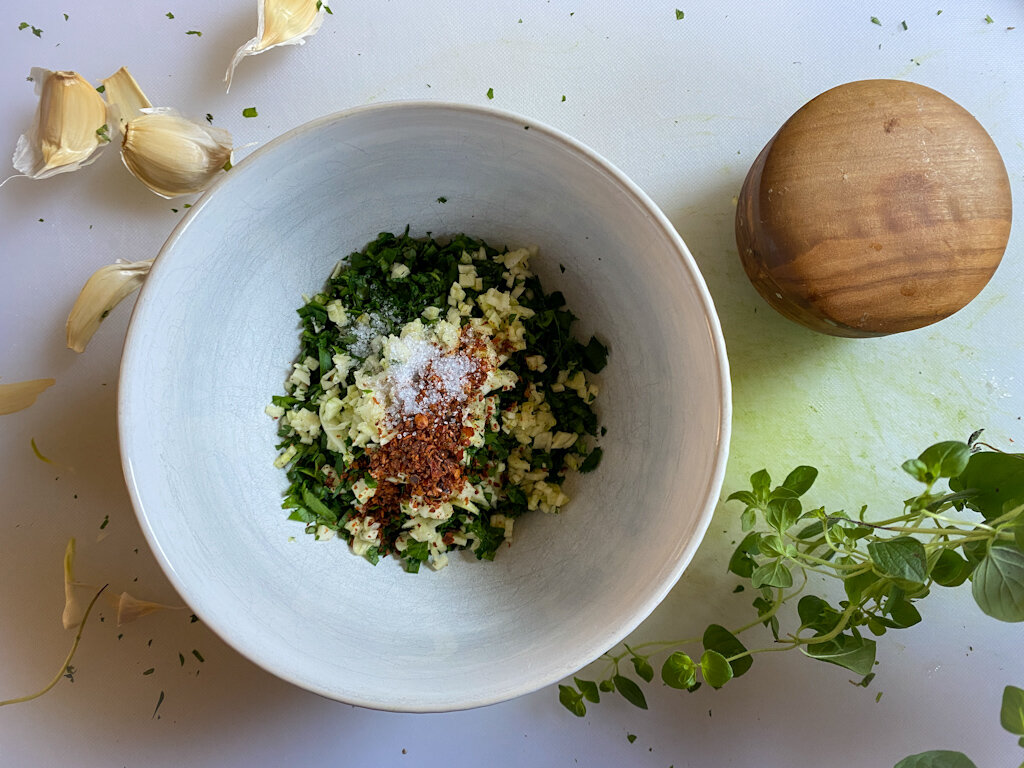By Leslie Brenner
Wouldn’t life be grand if you had an easy sauce you could whip together from a few raw ingredients (no cooking involved), and that little sauce could bring dramatic — even cheffy — dazzle to the simplest of plates?
Ah, but you do now! Cutting to the chase, and getting straight to the recipe: Tangy Green Everything Sauce.
I wanted a raw sauce that was fresh and packed with herbs — like an Argentine chimichurri or a Sicilian salmoriglio — but decidedly tangier than either of those, definitely with lots of shallots, and focused on herbs that are softer than assertive oregano. Parsley, dill and mint harmonize beautifully — and if your’e in the mood to change things up, you can layer in tarragon, chervil, cilantro or basil. Or even oregano, if that’s how you’re feeling! (I sometimes do.)
Tangy Green Everything Sauce was born. “Everything” is its middle name because it goes with nearly everything. A seared pork chop, butterflied leg of lamb, supermarket rotisserie chicken, simple grilled fish — any and all are transformed into something vivacious and delightful when they keep company with this sauce. Keep a jar of it in the fridge, and it takes the stress away from dinner. It doesn’t matter so much what exactly you throw in the pan; just grab what looks good, cook it simply with salt and pepper, and then pass around the Tangy Green Everything Sauce.
We could just leave it at that — but then the people who complain about recipes that are weighed down by pesky stories would have prevailed.
Instead, let’s parse chimichurri, since it is the honored great uncle of Tangy Green Everything Sauce. What defines chimichurri exactly, what are its origins, and when did it make its way to the U.S. and into our consciousness?
We know it’s from Argentina, that it’s a raw sauce of chopped parsley, fresh oregano, garlic, vinegar and oil. In Uruguay, where it’s also enjoyed, dried chiles make an appearance as well.
I can’t remember the first time I saw chimichurri or heard of it — and I’ve been unable to turn up much about the sauce, either among the food reference books on my shelves, or on the web.
(Hopefully there are chimichurri scholars out there somewhere who will jump in and shine a light on it in the comments section!)
I couldn’t find it indexed in Maricel E. Precilla’s Gran Cocina Latina: The Food of Latin America. There’s no entry for it in the encyclopedic Oxford Companion to Food (at least in the original 1999 edition; I just ordered the 2014 revised edition; will update if it’s there.) No mention in James Peterson’s Sauces, nor in Time-Life’s The Good Cook Sauces. Samin Nosrat doesn’t doesn’t include it in her discussion of vinegar-based sauces, or anywhere else I could find, in Salt Fat Acid Heat. J. Kenji López-Alt has a version in The Food Lab (lots of garlic, no shallots, and cilantro included with the parsley and oregano) — but not a word about what it is, where it’s from or its cultural provenance.
Isn’t this strange — such a ubiquitous sauce, yet so little coverage?
New York magazine published a chimichurri recipe back in 2009 that feels authoritative, from Francis Mallman, one of Argentina’s most famous chefs. Adapted from his cookbook Seven Fires: Grilling the Argentine Way (which I could have sworn I owned a copy of — can’t find it). It’s extremely garlicky; the recipe uses the whole head, garlic (no shallot), albeit blanched to take off the edge. Parsley and oregano are in there as well (not cilantro), with an olive oil to red wine vinegar ratio of two to one. But no history to go with it.
Joyce Goldstein gave us “The mysterious origins of chimichurri” in a San Francisco Chronicle story in 2012. “One story says it is a corruption of English words, most commonly the name Jimmy Curry or Jimmy McCurry, supposedly a meat wholesaler,” she wrote. She then cited Miguel Brascó, an “Argentine gourmet” who traced it to the failed British invasions of Argentina in 1806 and 1807, when the prisoners asked for “condiments for their food.” Another story points to Basque settlers in Argentina, also in the 19th century, who used the word tximitxurri, which loosely translates as "a mixture of several things in no particular order."
Finally, Goldstein cited a San Francisco chef, Staffan Terje, who noted that chimichurri is “practically identical” to Sicilian salmoriglio. We know there was significant immigration of Italians to Argentina in the 18th century. A Wikipedia article outlines some of the foods they brought with them, but makes no mention of salmoriglio.
The earliest mention in Anglophone print I turned up was 1998, when the New York Times’ then-restaurant critic Ruth Reichl published a “Diner’s Journal” piece about a just-opened restaurant on Ninth Avenue called Chimichurri Grill. After praising the place’s Patagonian toothfish, Reichl wrote, “But what Argentina is mostly known for is beef. It is well represented on the menu here and tastes particularly good with chimichurri sauce, a mixture of parsley, garlic, oil and vinegar that is the country's national condiment.”
That must be about the time chimichurri started to gain popularity in the U.S.
How long did it take to really take off? Hard to say. But just two years ago, in 2019, Nation’s Restaurant News announced that “The Latin American condiment is trending in the U.S.” Over the previous four years, the trade magazine reported an 83% increase in appearances on menus nationwide.
So yeah, it’s everywhere. And it’s delicious. Would you prefer chimichurri, or its fresh-faced new relative, Tangy Green Everything Sauce?
In my world, there’s room for both — and both will be appearing on my table again and again through grilling season.
Oh, you want that recipe, too? Bravo! You’re rewarded for reading to the end.




